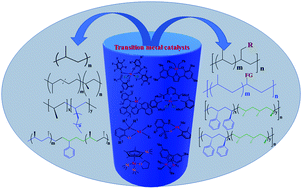Progress in propylene homo- and copolymers using advanced transition metal catalyst systems
Abstract
Transition metal catalysts have evolved dynamically in the last few years for propylene polymerization and copolymerization in homogeneous media. The trends in catalyst development have moved from modification of Group 4 metallocene catalysts to search for new generation catalysts, including non-metallocene catalysts and late transition-metal catalysts. These new designed catalysts can produce some specific microstructures and functional polyolefins, which are not possible with metallocene catalysts. The present perspective will focus on developments in the design of new transition metal catalysts for propylene polymerization and copolymerization with different comonomers. First, propylene polymerization and copolymerization with early transition metal catalysts are discussed including the reactivity and selectivity of propylene polymerizations in a rational manner. Second, late transition metal catalyzed propylene polymerization and copolymerization with polar functionalized comonomers are discussed in detail. Third, propylene copolymerization with cyclic/diene monomers using transition metal catalysts is discussed. Special emphasis is put on the catalyst structures, the polymerization characteristics, and the chemical and physical properties of the resultant materials.

- This article is part of the themed collection: 2021 Focus and Perspective articles


 Please wait while we load your content...
Please wait while we load your content...